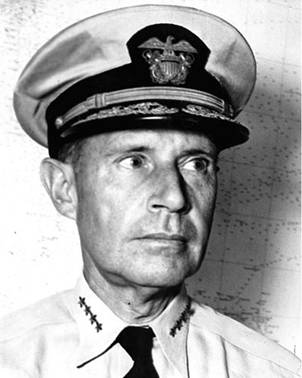- Author
- Sutton, Andrew, Sublieutenant
- Subjects
- WWII operations
- Tags
-
- RAN Ships
- None noted.
- Publication
- March 2009 edition of the Naval Historical Review (all rights reserved)
Admiral Raymond Spruance was one of the great Naval leaders of the 20th Century.
His decisions at the Battle of Midway and subsequent battles in the Pacific theatre of World War II were the mark of great leadership that saw him rise through the ranks to be Commander in Chief of the Pacific Fleet after the war had ended. He would subsequently lead the US Naval College and act as ambassador to Singapore.
Admiral Spruance came to prominence on the eve of the US Navy’s greatest ever test, the Battle of Midway. Carrier Task Force 16’s leader, Vice Admiral Bill Halsey, had fallen ill and needed to be replaced. Admiral Nimitz who was in overall command of the US Navy in the Pacific chose Rear Admiral Spruance on Halsey’s recommendation. Spruance had been leading Cruiser Division Five. Spruance had always served on traditional battleships, cruisers and destroyers but was now being asked to lead a task force which included the Aircraft Carriers US Ships Hornet and Enterprise. Vice Admiral Halsey was a popular military leader; he was charismatic, extroverted and inspirational. He was great for publicity and had a passionate hate for the Japanese people, which was popular with the press of the day. He was a naval aviator who knew aircraft carriers well and was very bold in his approach to using them. The fact that he was sick was not a good omen. The Midway Islands was a tiny set of islands that had an airfield, a fact that would make them a very important strategic asset that the US could ill afford to lose.
In Halsey’s place was the much more constrained Rear Admiral Raymond Spruance. His experience as a surface warfare officer would make him have a more conservative and precise view on air-sea combat. Spruance’s personality was also vastly different from his predecessor. ‘Spruance was quiet, reserved, and preferred reflection over constant interaction.’ Unlike Halsey who was a free spirit, Spruance was deliberate, methodical and paid attention to the finest details. The two are often compared as they had almost polar opposites of leadership styles yet both were considered great leaders. While Halsey would often act on gut instinct or rely on the advice from his subordinates, Spruance would meticulously and methodically plan everything and then hand over to his commanders who made it happen. Spruance’s leadership style could best be described as ‘hands-off’ because he would let his people do their thing and his subordinates appreciated this. Spruance was also a careful manager but because of his hands-off approach to leadership he was not micromanaging his subordinates. This indicated that he had high confidence in his subordinates, however when things did not go to plan he had to take responsibility for it.

Spruance arrived with the task force two days before the Battle of Midway and he brought with him only a single staff member. Spruance had to win the confidence of the ships’ crews and the aviators in very limited time before he would commit them to one of the most important battles in naval history. As Spruance was not an aviator, the task of winning over the pilots would prove all the more difficult as they were used to serving under Halsey—who was a qualified aviator himself. It was Captain Miles Browning, Chief of Staff that was in charge of Naval Air Warfare who would ultimately influence the outcome of the battle when he talked the rookie Carrier Task Force commander into launching the attack earlier than planned. For this he was awarded the Distinguished Service Medal.
Spruance would lead Task Force 16 deferring overall command of the major task group to Admiral Fletcher who brought with him Task Force 17 led by the severely damaged USS Yorktown. The Yorktown had only just survived the Battle of Coral Sea and was put back into action after only three days repairs when normally 90 days would be required. There were no battleships accompanying the US Task Groups because Admiral Nimitz felt they would be too vulnerable to attack from the skies and the battleships he had available would not be of adequate speed to catch the more modern Japanese vessels anyway. The days of the battleship dominating the high seas were over.




